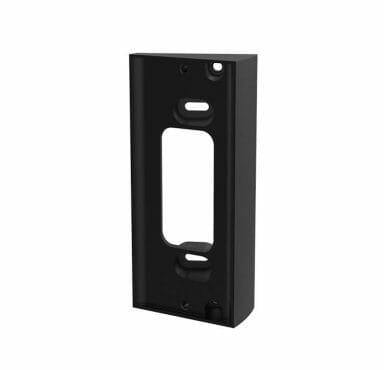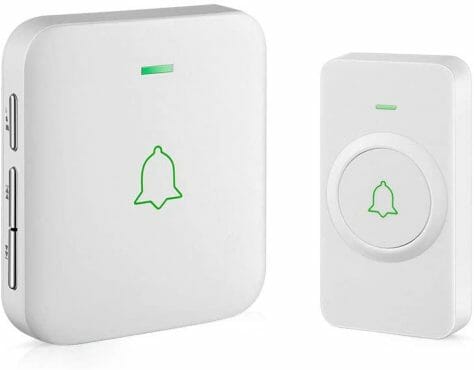More American homeowners are using wireless doorbells versus wired ones. Wireless doorbells are far more advantageous in many ways and are a technology that makes life easier. Are wired doorbells outdated and no longer needed in the market?
We have tested the two types of doorbells, and choosing which is best for you may be challenging. Here are the essential details you need to know between the two types of doorbells.
Quick Summary
Choose a wired doorbell if you prefer:
- Being practical and functional
- Traditional but high-quality doorbell sound
- More decorations to select for your house
- Consistent quality because it has a direct line and no signal interference
Choose a wireless doorbell if you prefer:
- Easy setup procedure
- No holes and wires on your wall
- Variety of doorbell sounds to choose from
- Useful additional features such as LED lights, audio, video recording, etc.
- Versatility and durability
- Higher security through the use of mobile apps
| Wired | Wireless | ||
| Pros | Cons | Pros | Cons |
| Practical and functional Due to its sound strength, it produces a high-quality tone Has numerous doorbell button designs to choose from Has direct line that ensures maximum consistency | Can be difficult to install as it needs to run wires through the walls The working range is limited | Simple to set up Various chime options Has long wireless doorbell range Background frequencies are blocked more effectively Have numerous features included, such as video and audio recording, night vision, LED indicators, and so on | Typically has a minimalist appearance but does not provide additional design options High-end wireless models (such as those with smart Wi-Fi capabilities) are more expensive. |
Wired vs Wireless Doorbells – How do these two differ from each other?
Doorbell systems are classified into two types: wired doorbells and wireless doorbells. Wired doorbells physically connect the chime unit to wired doorbell buttons. In contrast, wireless doorbells use radio signals or wifi to connect wireless systems.
Wired doorbells are less expensive than wireless doorbells. They are based on a basic electrical circuit. The system begins with a doorbell transformer, which converts standard household voltage to a lower voltage, 10v or 12v. The doorbell button will link to a transformer, connecting to a chime unit. When you press the button, the circuit will complete, and an electric current is used to power the chimes. (1)
Wireless doorbells are frequently more stylish, classy, and affordable. The doorbells are either battery-powered or powered by electricity. A battery-powered doorbell can be placed anywhere and is simple to install. The transmitter, which connects to the outdoor button, transmits radio waves to the receiving bell or speaker installed inside the house.
Wired Doorbell: Advantages and Disadvantages
Do you think wired doorbells are outdated? You might not think about it that much, but wired doorbells have more benefits than drawbacks.
Pros
- Practical and functional
- Due to its sound strength, it produces a high-quality tone
- Has numerous doorbell button designs to choose from
- Has direct line that ensures maximum consistency
Cons
- Can be difficult to install as it needs to run wires through the walls
- The working range is limited
Top Features
Easy Installation
Since your home may already have the wiring, it’s already relatively easy to install. A wired doorbell’s electrical wiring must run through the walls and connect to the doorbell system.
The wires connect to the transformer, install it next to the circuit breaker box to ensure that the proper voltage flows through the doorbell. Hiring a professional is necessary to install the doorbell properly.
Maintenance
Sometimes the wires get tangled or damaged, necessitating its replacement. Replacing a doorbell, as well as its maintenance or repair, can be costly. It’s because you must hire a professional to install, maintain, and, in some cases, replace the doorbell.
Lighted Button
You can install a button with lights on hardwired doorbells (doorbells that do not use batteries). Any battery-powered doorbell with a lighted pushbutton will have a shorter battery life than one without.
No Signal Interference
There’s no interference with the signal range in wired doorbells, as in wireless doorbells. It does not transmit radio frequency (RF) signals through the air. Signals from a wired doorbell travel through the wires or cables.
More Designs to Select
There are more designer options available if you choose a hard-wired doorbell. Retro brushed steel doorbell covers, ornate, antique metallic scroll designs, sleek wood doorbell covers, and other styles are available.
Traditional Chimes
Hard-wired doorbells are ideal for those who prefer classic doorbell chime tones with rich symphonic sound over whimsical sound options. A wired doorbell does provide different front and back door chime sounds, which is sufficient for you homeowners.
Wireless Doorbells: Why Homeowners Choose them
Pros
- Simple to set up
- Various chime options
- Have long wireless doorbell range
- Background frequencies are blocked more effectively
- Have numerous features included, such as video and audio recording, night vision, LED indicators, and so on (2)
Cons
- Typically have a minimalist appearance but does not provide additional design options
- High-end wireless models (such as those with smart Wi-Fi capabilities) are more expensive.
Top Features
Versatile
Because of the wireless doorbell’s adaptability, it is simple to relocate the doorbell to a convenient location. No wires are required. As a result, you won’t need to make major wiring changes to your home because you can easily mount the transmitter on the wall with screws or other simple fastening devices.
Installation is Easy
To attach the transmitter button to the wall, use an adhesive strip on its back. You can plug the indoor receiver into a wall or place a receiver with battery power anywhere in the house where you can hear it.
Durable
You don’t have to worry about maintenance related to malfunctions with wireless doorbells, as you do with wired doorbells. Wireless doorbells are more durable and don’t require as much upkeep.
No Home Changes Required
Some homeowners prefer not to drill holes in their walls (even if it’s just tiny holes) and run wiring through them. A wireless doorbell requires no drilling.
Sufficient Range
Signal ranges range between 150 and 1000 feet. With that range, the radio signals of a wireless doorbell can reach from the front porch doorbell button to the indoor receiver or inside the entire house.
Multiple Channel Operation
This feature protects your wireless doorbell from interference from a neighbor’s doorbell. If your doorbell is ringing when your neighbors have a visitor, you can simply change the frequency of your doorbell to a different channel.
Additional Receivers
Extenders (additional receivers) are available to relay the doorbell signal to your home. Portable receivers are also available. If you’re working in the backyard or garage, these will come in handy.
Long-Life Batteries
Long-life lithium batteries power the transmitter buttons that come with the transmitter. You could plug the receiver into a wall outlet or run on batteries inside your home. Most wireless doorbells can run for up to two years before you need to replace them.
Various Chime Selection
Many wireless doorbells provide several options if you want to change your doorbell’s tone, tune, or melody. This multi-tone feature is also helpful if you use multiple doorbell buttons. Like the front, back, and side door, each door can have its own tune.
Additional Features
- Security – Many wireless doorbells include a hidden camera with night vision. You can see, talk to, and record your visitors before opening the door with Wi-Fi with a video doorbell camera. Please keep in mind that wireless doorbells can interfere with Wi-Fi signals and RF waves that other devices emit in your home.
- LED Lights – Another essential feature is that the doorbell can flash LED lights. It is useful especially for people who have hearing problems or live in a home with lots of noise.
- Motion Detection – The wireless doorbell also detects motion or sound on your front door. It can notify you if there is a burglary attempt at your home.
- Mobile Integration – The integration of your wireless doorbell with mobile apps is very beneficial. You’ll see who is at your door from wherever you take your phone. You can also communicate with the person at your door by using the doorbell. Google Home and Alexa integration are two other forms of integration you can use.
Bonus: Wired vs Wireless Doorbell Camera
When installing a doorbell, it’s good to have a camera feature in it. So, talking about wired vs wireless doorbell cameras, each type offers unique benefits depending on the product and brand.
For a wired doorbell camera, there are products that generate fewer false alarms than any other video doorbell. Also, it has a subscription plan that allows it to differentiate between people, animals, cars, and packages.
For a wireless doorbell camera, there are simple options with good images and a battery that can last about four months on a single charge.
Wired Doorbell vs Wireless Doorbell – Which One is Best for you?

Now, you already know the benefits and drawbacks of wired doorbells vs wireless doorbells. The choice now depends on your preferences, budget, and purpose. The key features you require will determine whether you purchase a wired or wireless one.
Wrapping Up
Choose a wired doorbell if you prefer:
- Being practical and functional
- Traditional but high-quality doorbell sound
- More decorations to select for your house
- Consistent quality because it has a direct line and no signal interference
Choose a wireless doorbell if you prefer:
- Easy setup procedure
- No holes and wires on your wall
- Variety of doorbell sounds to choose from
- Useful additional features such as LED lights, audio, video recording, etc.
- Versatility and durability
- Higher security through the use of mobile apps
Note: Convenience and security are your primary goals for installing a doorbell. Hence, you must ensure that the price you’ll be paying will be working wonders for you and your family.
You may want to check other product and learning guides we’ve written that might help you in the future. Until our next article!
- Best Video Doorbell without Subscription
- How to Change Ring Doorbell Sound
- How to Save Ring Doorbell Video without Subscription
References
(1) electric current – https://www.britannica.com/science/electric-current
(2) audio recording – https://www.sciencedirect.com/topics/biochemistry-genetics-and-molecular-biology/audio-recording



